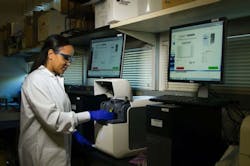We've made a lot of promises in the cell and gene therapy (CGT) industry.
And why shouldn't we? Thousands of CGTs are in clinical development, a market opportunity of $58 billion over the next five years is there for the taking, and lifesaving treatments will potentially eliminate life-threatening diseases for millions of people. The future is bright and filled with endless possibilities.
But here and now, several challenges threaten this rosy future, impeding current therapeutic development and scalable biomanufacturing. Critical design problems and inefficiencies cost CGT developers millions in wasted manufacturing spend, elevate the risk of adverse immune responses, and result in prohibitively high costs per dose that limits the breadth of indications these powerful treatments can address.
To give the current pipeline of CGTs the highest likelihood of success, we must address these problems. As an industry, we need to make drastic design process improvements to enable CGTs to realize their full potential and be embraced on a broader scale.
The solutions for some of CGTs development problems lie in the digital world. Specifically, computational life science tools and platforms are the latest innovation empowering drug developers. They provide yield optimization insights with advanced analytics-based models and give manufacturers proactive solutions to problems before they lead to companies millions in sunk costs.
Computation and the genomics revolution
The computational sciences made inroads into the biological sciences as genome sequencing became more widespread and the need for sequence analysis tools grew. Over the years following the near-complete sequencing of the human genome, genomics fully bloomed into a field of its own. Sequencing technology has also seeded other 'omics' fields, including transcriptomics, epigenomics, and multi-omics, all of which have further entrenched computational tools as an integral part of these fields.
With the complexity and variability of CGTs, genomics has been an essential technology for characterizing ex vivo>in vivo therapeutics throughout discovery, development, and manufacturing quality control. Single-cell sequencing, in particular, has helped developers more comprehensively assess transduction efficiencies and vector copy numbers of viral vectors or on-/off-target and zygosity of gene editing-based therapies.
Biomanufacturing challenges
Despite the success of computational life sciences, genomics, and currently approved CGTs, bottlenecks in developing and biomanufacturing CGTs still need to be addressed. Many challenges stem from inadequate viral vector design and resultant inefficient introduction of genetic material into target cells.
Viral vectors are complex biologics, and analytical testing to characterize yield and purity is not straightforward or standardized, providing many opportunities for error. Each analytical technique for viral vector characterization and/or QC needs to be developed and validated and at each step. In addition, many different culture systems and cell line options for viral vector biomanufacturing require testing, optimization, and validation.
Moreover, there are issues downstream of viral vector construction, where specific beneficial gene sequences are engineered into a well-established viral vector backbone. Viral vectors require significant sequence-based optimization to fine tune gene expression and ensure efficient packaging into a viral capsid. It is a time-consuming and costly process that requires vast amounts of trial and error that will dramatically affect the yield and purity of a viral vector.
As CGTs focus on broader indications that require larger-scale production, inefficiencies seen in small-scale production processes will be amplified. For our industry to advance, CGT developers must find more streamlined and efficient ways to generate high-quality viral vectors and overcome these challenges.
How AI can help
Much like it did with genomics, computational approaches are solving the above mentioned challenges. Applying advances in artificial intelligence (AI) and machine learning (ML) to the viral vector construct design issues is unlocking transformational breakthroughs in biomanufacturing efficiency and success. The in silico approach can increase the yield and purity of viral vector production and accelerate CGT development and manufacturing.
Here are some ways cell and gene therapy developers are applying AI to optimize biomanufacturing:
- DNA and protein feature prediction: Recently, large language models (LLMs) have been applied to DNA sequence analysis, enabling accurate functional prediction (e.g., promotors, enhancers, etc.). This allows viral construct designers to foresee gene expression complications using sequence analysis alone. LLMs can be further applied to protein analysis, giving cell and gene therapy developers the ability to accurately predict development and biomanufacturing outcomes.
- Epigenetic and variant effect prediction: Deep learning architectures – trained on epigenetic and transcriptional datasets – have been utilized to yield precise gene expression predictions. The ML algorithms use long-range interactions, as far as 100 kb away, for accurately forecasting the impacts of mutations and methylation. Again, these methods can be directly applied to construct optimization for viral vectors.
- Truncation propensity prediction: A major issue in viral vector biomanufacturing, specifically with adeno-associated viruses (AAVs), is the incomplete packaging of the viral genome into a capsid. These “truncated” AAVs reduce the potency and purity of AAV preparations. Deep learning (DL) can help in modeling and predicting truncation by identifying DNA sequences associated with truncation. This provides developers with insights that enable the optimization of constructs with a reduced propensity for truncation, improving the manufacturability of AAV-based gene therapies.
Unlocking CGT potential
AI, ML, and other advanced computational life science approaches are unlocking answers to CGT development and production challenges. By solving viral vector production issues, AI and ML are helping to streamline commercialization and bring life-saving treatments to those who need them faster and at a lower cost. With these computational and artificial intelligence advancements, the future of CGTs looks brighter each day, enabling our industry to make lifesaving treatments accessible to patients all over the globe.
